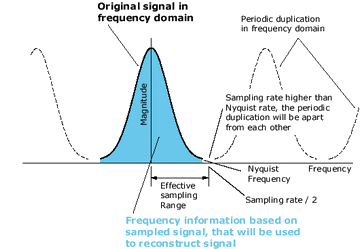| |
|
In frequency domain, sampling is equivalent to replication of the original spectrum to every integer multiple of the sampling frequency fs (so that the resulting spectrum becomes periodic). The reconstructing interpolation is equivalent to rejecting all replicas but the fundamental around zero frequency (they are filtered out, since the smoothing interpolation is equivalent to filtering). If the original signal is not properly band-limited, its replicas do not "fit", high frequency components overlap and the replicas cannot be removed anymore. The aliasing artifacts introduced by sampling of a non band-limited signal are usually very annoying.   A common practice to prevent aliasing, is to apply an antialiasing filter at the front-end of the digital system. This filter limits the bandwidth of the input signal to or below half the sampling frequency by rejecting the spectral components at and above this point. If the sampling frequency is sufficiently high, the dulling effect of the filter rejecting high frequency components is not very disturbing or even inaudible. For example, the sampling frequency of the CD-DA (Compact Disc - Digital Audio) system is 44,1kHz, and the antialiasing filter limits the bandwidth to 20kHz. |